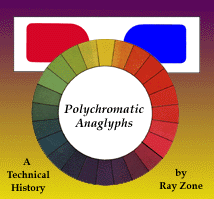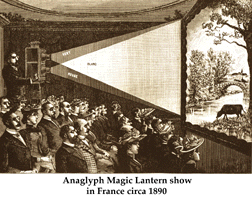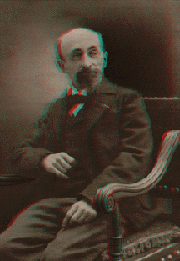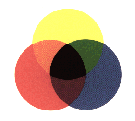

Though it was implemented shortly after the invention of stereography itself, the anaglyph has long been a highly recognizable but lowly stepchild in the arena of 3-D. Using complementary colored red and blue lenses for left and right eye image selection is a cost-effective way to present a 3-D image but many people are troubled by the color bombardment different to each eye necessary for the effect. Despite this, the anaglyph has proliferated and continues to do so as a viable means of stereographic presentation.
Increasingly, though the anaglyph is an inherently monochromatic, or black-and-white system, stereographic artists are using a fuller palette of color in the creation of this unique form of 3-D image. The polychromatic, or full color, anaglyph has had a relatively limited use up to the present day but new computer software promises to increase its application in a variety of media.

When stereoscopic views became tremendously popular in the 1850s, different investigators sought alternative means of displaying the stereo image. Helmholtz, in his Treatise on Physiological Optics, cites the work of Rollman who in 1853 illustrated the principle of the anaglyph using blue and red lines on a black field with red and blue glasses to perceive the effect. By 1858 Joseph DAlmeida began projecting three-dimensional magic lantern slide shows using red and blue filters with the audience wearing red and blue goggles.
The work of DAlmeida was continued by Molteni but it is to Louis Ducos Du Hauron of Algiers that we owe the first printed anaglyphs. Many of the 3-D pioneers, like Du Hauron, the Lumiere brothers and Frederick E. Ives, were exploring the nature of color in photography and it was through this work that their invention of anaglyphic processes came about. The thrust of their efforts was to create a more perfect replication of nature through photographic reproduction and the attempts to capture color as well as 3-D information in an image can be seen as an expression of that goal.

To Du Hauron we must credit the discovery of subtractive filtration, the active principle behind the anaglyph. In his 1869 book titled Les Couleurs en Photographie, Du Hauron disclosed many major facts concerning principles of color in both photography and printing. Seven years previous, in a letter of 1862 Du Hauron had written: Physical Solution of the Problem of Reproducing Colors by Photography.--The method which I propose is based on the principle that the simple colors are reduced to three --red, yellow and blue--the combinations of which in different proportions give us the infinite variety of shades we see in nature.
By exposing black and white negative film through filters of these colors, a three-color separation is produced. This is the underlying principle behind all color printing. In 1870 a three-color lithograph was produced by Du Hauron that demonstrated this principle.
With subtractive filtration in the anaglyph, it can be seen that the red lens sees the blue image and cancels out the red. The blue sees the red and cancels blue. Because a given color filter cancels out the same color in the photo or print it is called subtractive.

When panchromatic black-and-white film, or film that sees color, was invented in 1890 the mass reproduction of color photographs in magazine and newspaper supplements began to take place. Two-color anaglyphs also began to appear with many specially printed inserts. Throughout the 1890s and up to the 1950s there were many printed applications of the two-color anaglyph in magazines and newspapers.
